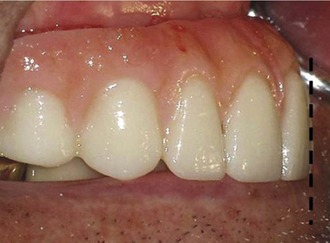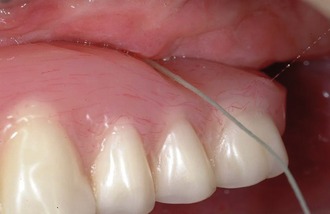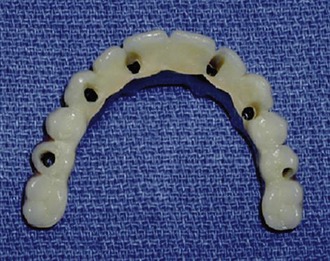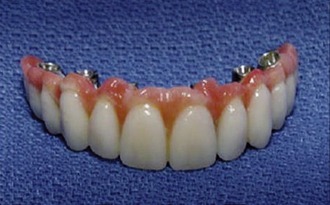CHAPTER 15 GRAFTLESS SOLUTIONS FOR ATROPHIC MAXILLA
The increased acceptance and understanding of the benefits of dental implants by the health care profession, as well as the general public, demand that consideration be given to developing guidelines for the treatment planning of edentulous patients using dental implants as a fixed, implant-supported prosthesis. The use of fixed, implant-supported prosthesis in the edentulous mandible has been well studied.1,2 However, the edentulous maxilla warrants special consideration and will be the focus of this chapter. Three principal designs for an implant-supported fixed maxillary prosthesis exist and are explored. Each design fulfills the aesthetic, phonetic, and hygienic demands of the patient.
Treatment of the edentulous maxilla with a fixed prosthesis presents with a set of unique problems. Patients who are missing their maxillary teeth, are often treatment planned with a removable implant retained, tissue-supported prosthesis (an over denture), secondary to limited residual alveolar bone and concerns about aesthetics and phonetics. In some cases, patients have been informed that they may not even be candidates for implant treatment at all. The use of a full conventional denture or an over-denture, leads to further atrophy of their alveolar bone3–5 resultant in loss of future function, creating a pool of unsatisfied patients seeking alternative treatment options to the conventional full maxillary denture or the maxillary over-denture.
This author’s practice includes physiological treatment planning for edentulous patients. Physiological treatment planning refers to the execution of a surgical and prosthetic treatment protocol that biomechanically mimics the physiological conditions that existed prior to the removal of the patient’s teeth. Maintenance of the edentulous alveolar bone is the goal. The existence of the alveolar bone depends largely on the internal loading, such as that provided by the tooth roots or dental implants.6 External pressure placed on the residual alveolar bone by the denture-bearing areas during occlusal loading increases the rate of alveolar atrophy. Fixed implant restorations are totally implant supported, without transference of load to denture-bearing areas, avoiding or minimizing the possibility of further resorption associated with tissue-borne prostheses. This chapter looks at alternative options to removable appliances and outlines the initial screening methodology for determining which of the three principal designs for a fixed, implant-supported prosthesis should be selected for the patient.
 Pretreatment Planning
Pretreatment Planning
To predictably plan treatment for patients with fixed, implant-supported prostheses, a systematic pretreatment approach to evaluating edentulous patients is essential.7 This approach to treatment planning will allow for better communication between the implant team and the patient, leading to a predictable and satisfactory aesthetic, phonetic, and functional outcome. A systematic pretreatment planning criterion exists for the evaluation of edentulous patients for the fabrication of conventional removable full dentures. McGarry et al.8 developed a classification of complete edentulisim using conventional removable dentures as the final treatment. The classification considers the quantity of the residual edentulous ridge, its morphology or topography, and the relationship of the maxilla to the mandible. Interarch space, tongue anatomy, and the attachment of the musculature to the edentulous ridge are considered. The possible need for preprosthetic surgical procedures prior to the fabrication of complete removable dentures is also evaluated. This evaluation criterion allows the treating team to comprehensively consider all the existing conditions with their patient and to forecast potential problems prior to the initiation of the treatment. The treating team and patient will be able to better predict the outcome by considering the preexisting conditions, which will lead to more realistic expectations for the conclusion of the treatment plan.
In reviewing the literature, Wood and Vermilyea9 concluded that a fixed maxillary prosthesis is not possible in most cases due to improper phonetics, lack of lip support, and inability of the patients to maintain adequate oral hygiene. The three objections cited by Wood and Vermilyea, although generally not experienced by the author, warrants exploration by reviewing the various aspects of a properly fabricated full denture in detail.
Lip Support
Proper lip support is established in part by the proper positioning of the incisal two thirds of the anterior maxillary teeth.10 In addition, the cervical one third of the anterior maxillary teeth is also responsible for upper lip support11 (Figure 15-1). A common mistake is to treat every edentulous maxilla as a Class I edentulous ridge, which lacks vertical and horizontal alveolar atrophy. For a Class I edentulous ridge the cervical region of the denture teeth is positioned directly over the ridge. However, most edentulous maxillae present with vertical and horizontal resorption of the maxilla. The horizontal resorption places the edentulous ridge posterior to the cervical portion of the denture tooth. If the necks of the denture teeth are placed directly over the ridge, a significant lack of upper lip support will be clinically evident. It is essential for the laboratory technician to communicate with the implant team and be aware of the clinical appearance of the patient in order to position the anterior maxillary teeth in the proper axis, thus avoiding the misdiagnosis of inadequate lip support using a fixed prosthesis in this group of patients.
Oral Hygiene
The relationship of the base of the profile prosthesis to the crest of the ridge is identical in contour to the pontic contours in fixed bridges. Patients may easily thread dental floss between implant abutments and clean the undersurface of the profile prosthesis if needed (Figure 15-2). In older patients or patients with limited dexterity, channels can be created in the bulk of the acrylic to guide the dental floss between the implants. A properly fabricated implant-supported fixed maxillary prosthesis is a functional, well-tolerated appliance for this group of patients.
 Systematic Evaluation of the Edentulous Maxilla
Systematic Evaluation of the Edentulous Maxilla
Prior to discussing each of the three factors for the systematic evaluation of the edentulous maxilla, it may be prudent to establish several baseline criteria. For a fully implant-supported, nonresilient maxillary restoration, the implant support requirements of all three fixed restorative options discussed in this chapter are the same. A minimum of four implants should be used, although the option to place more than four may be considered, depending on the available bone volume and other functional considerations.12,13 Rather than the number of implants used, what is most important is the arch form distribution of those implants with both posterior and anterior support. Evaluation of the three radiographic zones allows for a preoperative determination of whether adequate arch form support for a fixed restoration is achievable to support the planned occlusal plane. As a general principle, cantilevers in fixed maxillary restorations should be avoided or minimized to one tooth to achieve an adequate functional occlusion.14–18 Many published reports detail the use of fixed prostheses to restore the completely edentulous maxilla.19–22 This discussion will focus on the application of three principal designs for implant-supported dental prostheses. These three variations have been chosen based on their ability to restore a broad range of soft tissue deficits: (1) the metal-ceramic restoration, (2) the fixed hybrid restoration, and (3) the fixed removable restoration.
Metal-Ceramic Restorations
Metal-ceramic restorations may be either screw- or cement-retained.23–25 This restoration is indicated for patients who present with intact residual hard and soft tissues and are only missing teeth. Recognizing that most edentulous patients present with some degree of hard and soft tissue atrophy, the use of a ceramic restorations is not indicated as many of the patients will have longer than normal length teeth with an unaesthetic clinical appearance (Figure 15-3).
Implant-Supported Fixed Prosthesis: Profile versus the Hybrid Prosthesis
The profile prosthesis is a milled titanium or cast-gold framework with Hi-impact acrylic teeth and pink acrylic (Figure 15-4). Some clinicians may substitute porcelain teeth and pink porcelain instead of using acrylic. Early designs of implant-supported fixed prostheses with denture teeth and pink acrylic, the hybrid prosthesis, had reported phonetic changes as a routine complication due to air escaping during speech.26 The later design, the profile prosthesis27 used a framework design that allows the acrylic resin to wrap around the metal frame-work and on the intaglio surface of the bar to have acrylic against the tissue similar to an ovate pontic eliminating air escape and phonetic problems.27 If a porcelain restoration is desired, a variation of this design uses pink porcelains with all-ceramic teeth against the metal framework.
Stay updated, free dental videos. Join our Telegram channel

VIDEdental - Online dental courses






